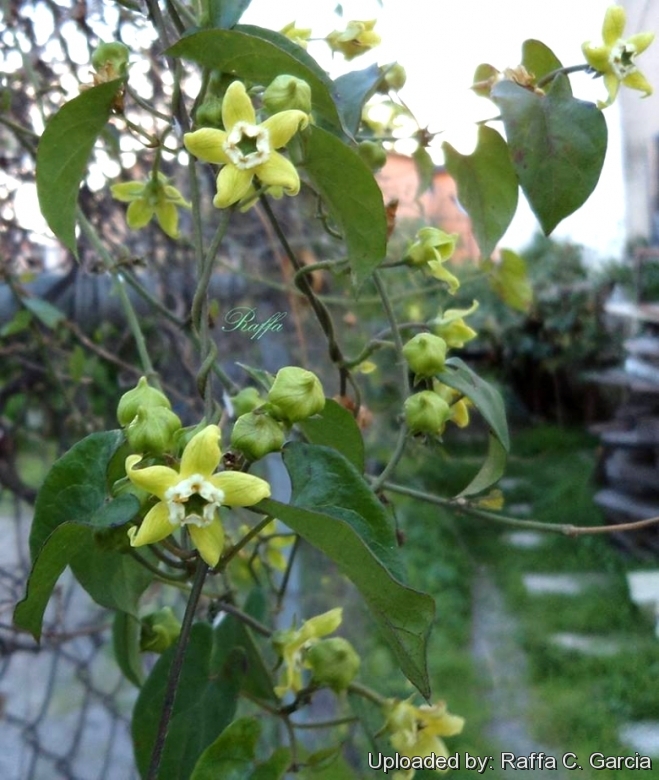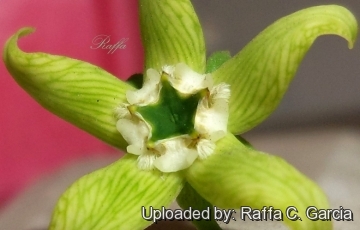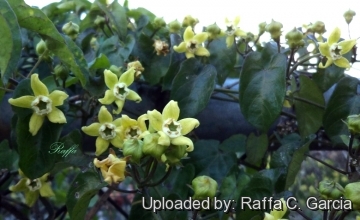
Gonolobus pectinatus Photo by: Raffa C. Garcia
Origin and Habitat: Puebla and Oaxaca, Mexico.
Type locality: San Luis Tultitlanapa, Puebla.
Habitat: Secondary deciduous forests.
Synonyms:
Description: Gonolobus pectinatusSN|30336]]SN|30336]] is a climbing plant either herbaceous or shrubby with umbels of green flowers.
Stems: Puberulent and sparsely hirtellous or glabrate.
Leaves: Opposite, broadly ovate-cordate, 3 to 6 cm long, short-acuminate.
Inflorescence (umbels): Short-pedunculate, few-flowered either axillary or terminal.
Flowers: Pedicels long and slender. Corolla subrotate, greenish, about 13 mm long.
Fruit: Ovoid, about 9 cm long, 5-winged.
Seeds: Hairy.
Bibliography: Major references and further lectures
1) Paul Carpenter Standley “Trees and Shrubs of Mexico: Passifloraceae-Scrophulariaceae” U.S. Government Printing Office, 1924
2) T. S. Brandegee, 1909 In: Univ. Calif. Publ. Bot. 3: 387
 Gonolobus pectinatus Photo by: Raffa C. Garcia
Gonolobus pectinatus Photo by: Raffa C. Garcia Gonolobus pectinatus Photo by: Raffa C. Garcia
Gonolobus pectinatus Photo by: Raffa C. Garcia Gonolobus pectinatus Photo by: Raffa C. Garcia
Gonolobus pectinatus Photo by: Raffa C. GarciaSend a photo of this plant.The gallery now contains thousands of pictures, however it is possible to do even more. We are, of course, seeking photos of species not yet shown in the gallery but not only that, we are also looking for better pictures than those already present.
Read More... Cultivation and Propagation: Gonolobus pectinatusSN|30336]]SN|30336]] is an excellent climbing plant, but seldom seen in culture. It can quickly become overwhelming, it is better to install support for stems, and when in bloom it is a very interesting plant.
Growth rate: Although the vines can reach considerable lengths in the wild, cultivated plants generally extend 1,5-2 m, twisting around supports to which they cling or hanging down in attractive cascades from suspended pots.
Potting medium: It benefits from being potted up in a very well-draining and porous potting medium that allows some air to get to the roots; typical mixes include, peat, with some fibrous soil and sand along with large-grade drainage material such as perlite, pumice, or lava grit. The medium needs to be moisture-retentive.
Fertilization: Need a perfect fertilizer diet including all micro nutrients and trace elements. Micronutrient deficiencies are occasional problems. Micronutrient deficiencies only show up on soil with a high pH.
Watering: Water regularly in summer, but do not overwater (wet-sensitively). Its roots are easily lost in pots that stay damp for any length of time. Keep quite dry with ample airflow in winter. In the rest period no high atmospheric humidity. Care must be taken with watering as they tends to become untidy in growth habit if given too much water and shade.
Exposition: This species prefers bright light, but will tolerate much less. Outside half shade to shade (filtered sunlight or afternoon shade tolerated), inside it will need a reasonably light room in order to actually grow, although it will still get by even in a shadier spot. It subject to sunburn if exposed to direct sun for too long. Tends to bronze in strong light, which encourages flowering and heavy leaves production.
Hardiness: The optimal temperature is 10-30°C. Minimum temperature: 4 ° C.
Spring: When winter ends and they begin to grow again, they will require much water and soaking the pots will no longer put the plants at risk for rot. In the spring they will grow well in partial shade and leaving them out in the rain may provide them with the water they need.
Summer: In the summer months they will tolerate heavy rain, but will be just as happy if the season is dry. They will tolerate hot weather outdoors as long as they are kept in strongly filtered light and this will encourage them to flower. They also enjoy some fertiliser. Moving the plants as they are developing buds may cause them to spontaneously abort the flowers all together.
Autumn: In the fall keep them outdoors until the night time temperatures drop below the 10°C.
Winter: Winter care presents no problems at 10° C with plenty of light. In winter be sure to take extra precautions to keep them dry, because damp cool conditions when the plants are resting is an invitation to fungal infections, but - according to temperatures –some occasional lit watering may be useful.
Maintenance: Prune the plant lightly to keep it tidy.
Repotting: Re-pot every 2 years.
Pest and diseases: Gonolobus are generally fairly easy to grow, especially if kept pest-free. They are very susceptible to stem and root mealy bugs, and damage from these may well initiate fungal attack. Any time when there is a dead or dying stem it is important to remove it immediately and completely before other healthy stems can become ill too.
Toxicity: Not known
Propagation: Sowing and cuttings.













